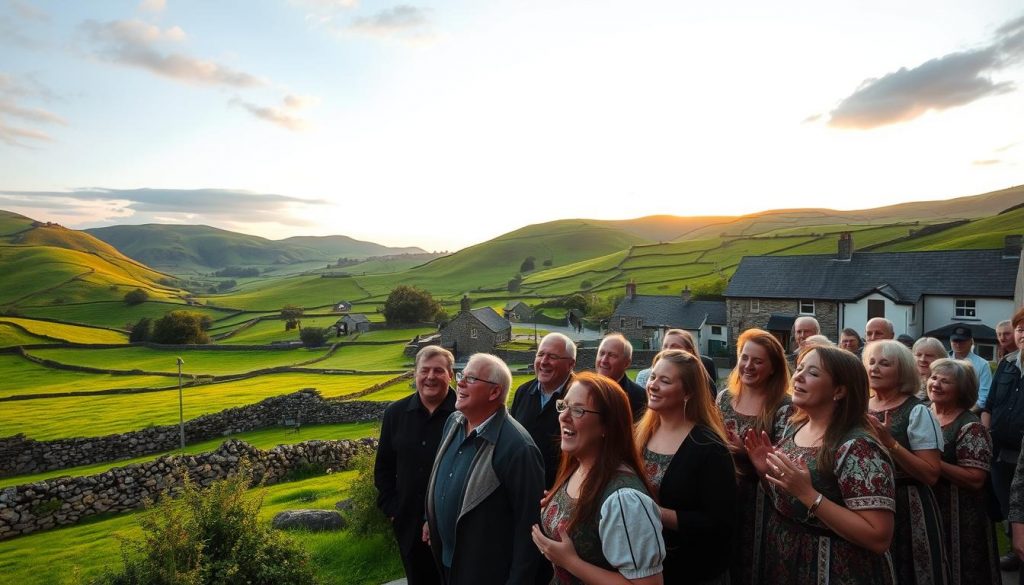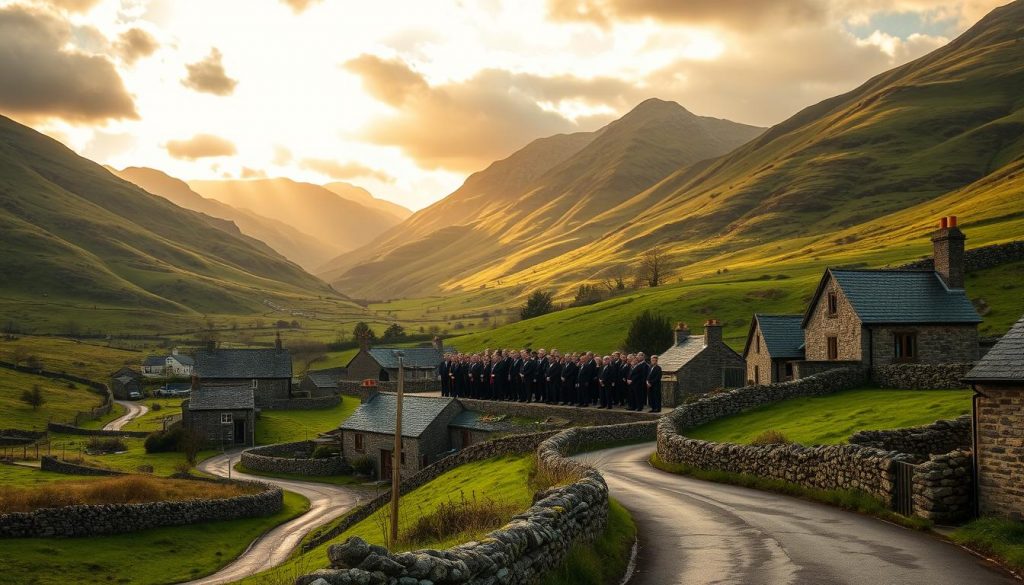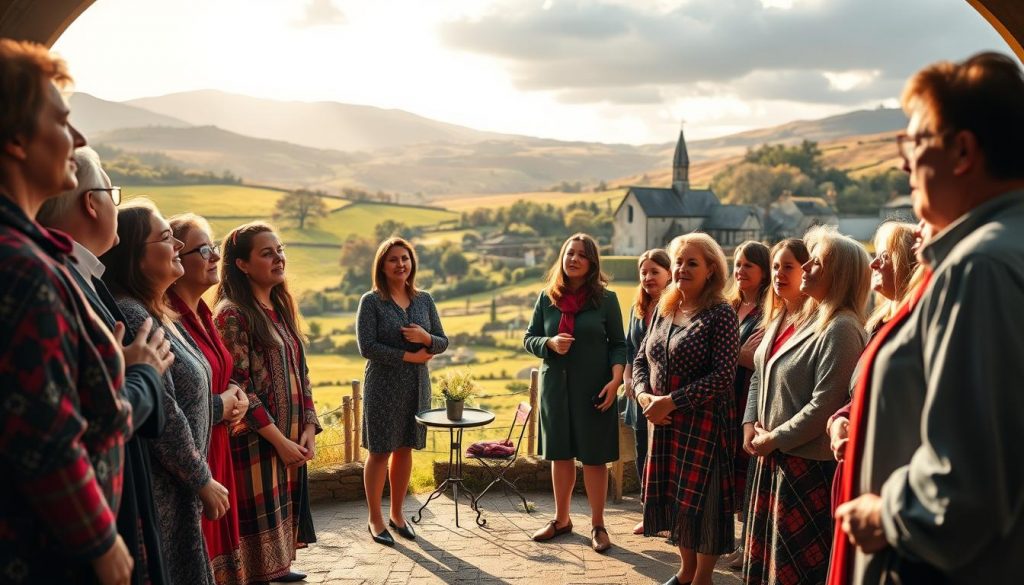Les chorales rurales galloises et la culture du chant communautaire
Fait surprenant : Au XIXe siècle, environ 80% de personnes fréquentaient la chapelle, et ce chant de messe a façonné un son national ressenti bien au-delà du Pays de Galles.
Annonces
L'histoire se déroule des bancs de chapelle aux salles minières, puis sur les scènes mondiales. Guide ultime explique comment une chorale a commencé comme un culte et est devenue un emblème culturel.
Les lecteurs trouveront une histoire vérifiée, des voix communautaires vécues et des exemples pratiques.

Les sections couvrent les racines non-conformistes, les changements industriels qui ont formé des chœurs vocaux et les raisons pour lesquelles les ensembles vocaux masculins se sont développés dans les villes du sud et du nord du Pays de Galles.
Annonces
Attendez-vous à des profils de Treorchy, Pendyrus et Morriston Orpheus ainsi qu'à des dates et des lieux.
Cet article allie témoignages communautaires et faits, ainsi que des liens vers les sites web de chaque chorale pour accéder aux détails des concerts, aux archives et aux médias. De nombreux sites web incluent une mention relative aux cookies pour améliorer l'expérience utilisateur.
Pourquoi c'est important : La tradition est une pratique vivante, mêlant hymnes, chœurs d'opéra et pièces de théâtre modernes, et elle continue de façonner l'identité des terrains de rugby et des salles internationales.
Pourquoi les chorales rurales galloises résonnent encore au pays de la chanson
Le chant communautaire dans les vallées et les villes façonne toujours la façon dont les gens entendent la voix de la nation. Cet article explique le lien vivant entre la vie quotidienne et les scènes mondiales.
Il montre pourquoi le son d'une chorale locale est passé des hymnes de chapelle à des lieux tels que le Royal Albert Hall, l'Opéra de Sydney et le Carnegie Hall de New York, et résonne même lors des matchs nationaux de rugby au Principality Stadium.
Le guide donne des informations claires et fiables sur l’histoire, le répertoire et les rôles sociaux.
Les lecteurs trouveront des portraits d'ensembles, des exemples comme Only Men Aloud et Only Boys Aloud, et une analyse de la façon dont le travail dans le sud du Pays de Galles a influencé le timbre vocal.
Pourquoi c'est important : l'arc émotionnel des points culminants de l'hymne « Amen », le drame lyrique et la chaleur du théâtre musical expliquent pourquoi la musique émeut les gens.
La programmation moderne mélange le gospel et la pop avec des morceaux traditionnels, de sorte que les chœurs vocaux se connectent à de nouveaux publics tout en honorant la tradition.
La plupart des chorales disposent d'un site Web officiel et d'une présence active sur les réseaux sociaux où les utilisateurs peuvent parcourir le contenu, consulter les médias et consulter les concerts ; comme pour de nombreux sites Web, un avis de cookie peut apparaître pour améliorer l'expérience utilisateur.
Ce guide promet des parcours fiables et structurés à travers l'histoire, le répertoire et les études de cas.
Chaque section propose des enseignements pratiques pour que les lecteurs puissent comprendre comment fonctionne un chœur d’hommes et pourquoi cette musique continue de voyager à travers le monde.
+ Linguistique pop : comment la musique pop influence le vocabulaire mondial
Des chapelles au charbon : les racines historiques des chœurs d'hommes gallois
L'alphabétisation musicale des chapelles non-conformistes a rencontré les réseaux sociaux de l'industrie lourde, et le chœur d'hommes est né.
Au XIXe siècle, environ 801 personnes fréquentaient la chapelle. Ce chant régulier permettait d'apprendre le chant à plusieurs voix, la lecture à vue et un répertoire partagé.
À mesure que les hommes quittaient les paroisses rurales pour s'installer dans les mines d'ardoise du sud du Pays de Galles et dans les villes d'ardoise du nord du Pays de Galles, ils emportaient avec eux l'hymnologie et l'habitude de l'harmonie.
La vie nocturne dans les instituts de mineurs, les pubs et les salles des fêtes permettait à des groupes formels de se former.
Des jalons concrets marquent son essor. Le Chœur d'hommes de Treorchy a été fondé en 1885 et a chanté pour la famille royale à Windsor en 1895.
Cwmbach est apparu en 1921 ; Pendyrus s'est formé en 1924 et, pendant les difficultés de l'entre-deux-guerres, avait environ 80% sur 150 choristes au chômage.
L'Eisteddfod national de 1938 comptait cinq chorales de chômeurs, démontrant ainsi comment le chant soutenait le moral dans les années difficiles. Les chorales sont passées de petites fêtes à de puissantes formations d'une centaine de chanteurs ou plus.
| Année | Ensemble | Importance |
|---|---|---|
| 1885 | Treorchy | Fondation; commandement royal à Windsor (1895) |
| 1921 | Cwmbach | Formation locale d'après-guerre |
| 1924 | Pendyrus | Grand chœur; chômage élevé parmi les membres |
Industrie lourde—poussière de charbon, loges et équipes—créaient des liens sociaux denses où une chorale servait de ciment civique.
Les archives et les chronologies apparaissent souvent sur le site Web d'une chorale pour permettre aux utilisateurs d'explorer les programmes de concerts et les coupures de presse.
En bref: La tradition s'est développée à partir du culte et du travail, transformant la vie quotidienne en une forme publique d'expression culturelle qui a voyagé au-delà du Pays de Galles vers le monde entier.
De nombreux sites Web utilisent un cookie pour mémoriser les préférences des utilisateurs lors de la consultation de contenu historique.
Lire aussi : Les gauchos argentins et le code d'honneur rural
Le son du travail : identités régionales, des ténors du sud du Pays de Galles aux basses du nord du Pays de Galles
Le son portait l’empreinte des fourneaux et des fosses, donnant à chaque chœur une tonalité familiale reconnaissable.
Le folklore raconte que la poussière de charbon éclaircissait le timbre des ténors dans le sud du Pays de Galles, tandis que le travail dans les carrières conférait le poids profond associé aux basses dans le nord du Pays de Galles.
Cette affirmation relève davantage d'une histoire communautaire que d'un fait scientifique strict. Elle permet d'expliquer comment les gens perçoivent leur propre culture et leurs traditions.

Au-delà du mythe, plusieurs mécanismes plausibles ont façonné la voix régionale. L'acoustique des chapelles, l'inflexion de la langue, le choix du chef d'orchestre et les exigences physiques du travail ont affecté le contrôle et la projection du souffle.
Ces éléments combinés confèrent aux ensembles de voix masculines une signature locale.
« Les gens apprenaient à chanter en travaillant ; l’usine et la fosse enseignaient la projection autant que la chapelle. »
Exemples locaux concrétiser l'idée. Pendyrus et Treorchy évoquent l'éclat des mines de charbon ; Dunvant et Morriston Orpheus évoquent les tons doux du travail des métaux.
Le public a appris à s'attendre à un éclat de ténor ou à une base de basse et les juges ont utilisé cette identité en compétition.
| Lieu | Lien industriel | Son perçu |
|---|---|---|
| Vallées du sud du Pays de Galles (Treorchy, Pendyrus) | Extraction du charbon | Ténors brillants ; lignes supérieures projetées |
| Région de Swansea (Morriston, Dunvant) | Métallurgie, fours | Registre moyen doux et arrondi |
| Nord du Pays de Galles (région d'Eryri) | Carrières d'ardoise | Basses profondes ; voix graves lourdes |
Il y a quelques années, les risques professionnels étaient réels, mais les communautés ont transformé leur courage en art.
Les auditeurs peuvent comparer des extraits de concerts sur le site Web d'une chorale pour entendre les différences ; un ou plusieurs cookies peuvent apparaître lorsqu'un utilisateur diffuse du contenu sur un tel site Web.
Que la poussière de charbon ait ou non littéralement altéré les cordes vocales, ce récit est une vérité culturelle. Il célèbre la façon dont le travail, le lieu et la musique se combinent pour façonner l'identité d'une chorale, que les gens perçoivent aussi clairement qu'ils lisent des informations historiques.
+ Les nomades de la mer : le peuple Bajau et ses adaptations sous-marines.
Au cœur d'une chorale masculine galloise : sections, répertoire et pratique de l'interprétation
Une chorale de voix d'hommes est une machine de pièces finement équilibrée, où les ténors et les basses aigus s'entremêlent pour créer un son vivant unique.
Quatre sections principales : Ténor aigu, second ténor, baryton, basse. Les ténors aigus portent la ligne sonore ; les seconds ténors apportent le soutien ; les barytons apportent la couleur intérieure ; les basses fournissent la fondation.
Ensemble, ils offrent à la fois une brillance climatique et une texture chaleureuse.
La culture des répétitions est centrée sur des hommes amateurs qui se réunissent régulièrement, souvent deux fois par semaine. Les séances portent sur les voyelles, la diction, la fusion et le coaching par sections.
Les directeurs et les accompagnateurs, qui sont peut-être les seuls membres du personnel rémunérés, insistent sur des normes professionnelles.
La programmation mélange des hymnes et des airs nationaux avec du gospel, des ballades d'Elvis, des morceaux du West End et des arrangements audacieux comme Bohemian Rhapsody.
Les chefs d’orchestre façonnent le phrasé, l’équilibre et les choix aventureux tels que les enregistrements avec des fanfares militaires ou les collaborations scéniques.
« Une présence régulière et un travail en sections transforment un ensemble amateur en une unité soignée. »
| Élément | Pratique | Effet |
|---|---|---|
| Sections | Ténor supérieur, deuxième ténor, baryton, basse | Lignes claires, texture intérieure, base solide |
| Répétition | Exercices de voyelles, diction, coaching sectionnel | Mélange et brillance professionnelle |
| Programmation | Hymnes, gospel, pop, opéra | Engagement du public et tradition |
| Performance | Contraste dynamique, support de l'accompagnateur | Étendue et cohésion émotionnelles |
Des concours et des vitrines, notamment le concours de longue date du Jeune chanteur gallois de l'année, permettent de maintenir un vivier de talents solo.
De nombreuses chorales publient des programmes et des calendriers de répétition sur leur site Web afin que les utilisateurs puissent trouver des informations et du contenu ; les sites Web affichent généralement un avis de cookie lorsque les utilisateurs diffusent des enregistrements.
Conseils d'écoute : concentrez-vous sur l'équilibre ténor-basse, la diction dans les deux langues et la façon dont la salle réagit à la couleur de l'ensemble.
Les chorales rurales galloises dans la vie communautaire : camaraderie, attention et identité culturelle
Au cœur de chaque ensemble villageois se trouve un réseau de soins pratiques qui permet aux membres de chanter dans les bons comme dans les mauvais moments.

Ils fonctionnent comme une famille élargie. Les hommes prennent soin les uns des autres en les accompagnant à leurs rendez-vous, en partageant des repas et en s’aidant mutuellement après une maladie.
Un exemple frappant : après qu'un membre ait souffert d'un problème cardiaque suite à une représentation à la cathédrale d'Ely, des collègues choristes se sont rendus à Cambridge pour le ramener chez lui, lui et ses affaires.
Les rythmes hebdomadaires comptent. La répétition dans une chapelle à côté du pub se termine par un thé, des discussions musicales et des rires.
Ces petits rituels maintiennent le moral au fil des années et ancrent les chanteurs plus âgés ou célibataires qui comptent sur le groupe pour leur compagnie.
Pendant la pandémieLe chant à distance a préservé les liens. Le retour aux répétitions en présentiel a ravivé un souffle commun et un sentiment d'appartenance profondément émouvant pour beaucoup.
« Ils n’étaient pas seulement des collègues sur scène ; ils étaient de la famille quand les choses tournaient mal. »
De nombreux ensembles s'associent à des églises et des centres communautaires. Ces collaborations intègrent les valeurs traditionnelles galloises de convivialité dans des concerts, des œuvres caritatives et des événements commémoratifs.
| Aspect | Exemple | Impact |
|---|---|---|
| Soins pratiques | Soutien d'Ely à Cambridge | Aide immédiate; rétablissement durable |
| Routine hebdomadaire | Répétitions à la chapelle, rassemblements au pub | Continuité sociale; orientation musicale |
| La résilience moderne | Chanter à distance pendant la pandémie | Liens maintenus; retrouvailles émotionnelles |
Le public et les nouveaux membres peuvent trouver des informations et le contenu des événements sur le site web officiel de chaque chorale. Veuillez noter que de nombreux sites web affichent une brève invite de cookie avant la diffusion d'un contenu multimédia.
Le point durable : La chorale perpétue la culture et la langue à travers son répertoire et ses rituels. Plus que la performance, c'est sa pratique quotidienne de soins qui explique la pérennité de cette tradition à travers le temps et le monde.
Études de cas et héritage moderne : Morriston Orpheus, Treorchy, Pendyrus et au-delà
Ces études de cas retracent comment quelques ensembles locaux sont devenus des ambassadeurs internationaux du chant communautaire.
Orphée de Morriston Créé en 1935 après une scission sur la direction musicale, le chœur Morriston Orpheus a eu huit directeurs musicaux à ce jour et allie chants traditionnels et programmes éclectiques.
Le chœur d'Orphée s'est produit sur de grandes scènes telles que l'Opéra de Sydney, au Carnegie Hall quelques semaines après le 11 septembre et à la gare Grand Central.
Ces apparitions montrent comment une chorale d'hommes du sud du Pays de Galles a atteint le monde.
Treorchy remonte à 1885 et a obtenu une commande royale pour chanter à Windsor en 1895, un signe de prestige de longue date.
Pendyrus (1924) a enduré les dures années de l'entre-deux-guerres, lorsque l'industrie lourde a laissé de nombreuses personnes sans travail, mais la chorale Pendyrus a maintenu un moral et des normes élevés.
Cwmbach (1921) s'inscrit dans ce modèle : des groupes locaux se sont formés dans les districts industriels et ont contribué à consolider l'identité des chorales galloises à travers le répertoire et la compétition.
« Ces ensembles protègent un son emblématique tout en ouvrant la voie à de nouveaux chanteurs. »
| Ensemble | Fondé | Héritage |
|---|---|---|
| Orphée de Morriston | 1935 | Tournées mondiales; prix jeunesse; répertoire varié |
| Treorchy | 1885 | Performance royale; longue histoire |
| Pendyrus / Cwmbach | 1924 / 1921 | Résilience communautaire; présence de la concurrence |
Les victoires médiatiques comme celle d'Only Men Aloud en 2008 ont stimulé des programmes pour les jeunes tels que Only Boys Aloud, créant des voies vers les chorales vocales et assurant des années de continuité.
Les lecteurs peuvent consulter le site web officiel de chaque chœur pour consulter l'historique des tournées, les biographies des chefs et les enregistrements. La plupart des sites web affichent une brève notification relative aux cookies avant la diffusion d'un contenu, afin que l'utilisateur puisse accéder aux informations et aux médias.
Conclusion
Ces ensembles conservent une voix publique qui relie le quotidien aux salles de spectacle du monde entier. Ils continuent de chanter dans les grandes salles et les salles locales, et sont des expressions vivantes de leur identité.
Note pratique : les auditeurs doivent se concentrer sur le phrasé, le mélange et la diction pour entendre ce qui rend un groupe unique.
Assistez à un concert, diffusez un enregistrement ou suivez des événements de sensibilisation dirigés par des réalisateurs qui planifient des flash mobs et des programmes scolaires.
Regard vers l'avenir : Une sensibilisation soutenue et l'engagement des jeunes contribueront à préserver cet art. Pour les curieux, soutenir des spectacles locaux ou participer à des ateliers pédagogiques est un moyen évident de rester impliqué dans les chœurs d'hommes et de les accompagner dans leur développement.
